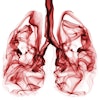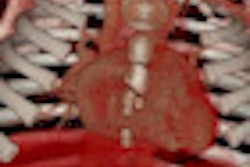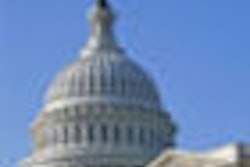VIENNA - High-pitch dual-source CT (DSCT) exams can evaluate the coronary arteries using about a third of the dose of even prospectively triggered exams, according to a study presented in Thursday's cardiac sessions of the European Congress of Radiology (ECR).
Image quality was equivalent to that produced by both prospective and retrospective triggering.
"High-pitch scanning is not possible with a single-source scanner because if you increase the pitch, you have gaps in the data acquisition," said Dr. Wieland Sommer from Ludwig Maximilian University in Munich, Germany. "With a dual-source scanner, a second source covers these gaps and, therefore, you can increase the pitch by a factor of 3.4 [for] a very fast acquisition of the entire thorax, and you need about three seconds for the entire heart."
Another advantage of DSCT is the higher temporal resolution (83 msec), enabling acquisition without motion artifacts, Sommer said. A previous study by the group using high-pitch protocols in chest pain patients found excellent image quality up to about 65 beats per minute (bpm), he said.
The two-part study aimed to evaluate high-pitch cardiac CT protocols, measuring radiation dose and image quality both in an Alderson Rando phantom and in a group of 78 patients with suspected coronary artery disease -- with patients excluded for contraindications to iodinated contrast agents.
In the patient arm of the study, patients were assigned to one of three protocols based on their heart rate, he said.
"For regular heart rates below 65 bpm [n = 33] we used the high-pitch protocols, and for heart rates from 65 to 100 bpm [n = 29] which are regular we used the prospective triggering step and shoot mode," Sommer said. For regular heartbeats ≥ 100 bpm or irregular heartbeats (n = 16 arrhythmias), the retrospective gating protocol was used to ensure the lowest possible dose and a diagnostic exam for every patient, according to Sommer.
For the first part of the study, researchers packed the phantom with 58 thermoluminescent detectors and simulated three cardiac CT scan protocols using a high-pitch DSCT protocol (Somatom Definition Flash, Siemens Healthcare, Erlangen, Germany), recording the equivalent dose using International Commission on Radiological Protection (ICRP) 60 protocol.
- High-pitch protocol (2 x 100 kVp, 3.4 pitch)
- Prospectively gated scan (100 kVp, 128 x 0.6 mm, 1.2 pitch)
- Retrospectively gated scan (100 kVp, variable mAs, electrocardiographic pulsing interval at 30% to 80% of the RR cycle, 0.3 pitch)
They calculated effective radiation dose for all three types of scans:
|
Coronary CT angiography scan results in an anthropomorphic phantom and 78 patients show equivalent image quality with far lower doses using a high-pitch DSCT protocol
There were no nondiagnostic exams, but as established in the literature, overall image quality was best in the patients with the lowest heart rates, he said.
But in patients who were scanned using the ultrafast high-pitch acquisition, contrast enhancement rates were higher, even though the same contrast dose was used in all three groups.
"Overall, the high-pitch protocols only need a fraction of the radiation dose of the CT protocols, and the dose savings are nearly 90% in the case of retrospective gating, and more than 60% compared to the step-and-shoot [prospective] mode," Sommer said.
High-pitch scans of the coronary arteries produce high image quality of coronary artery segments, when used in patients with stable heart rates below 65 bpm, he concluded.
Moreover, "the faster scans may lead to optimized flow rates and even higher attenuation values," Sommer said, adding that this question deserves further analysis in future studies.
The retrospective dose might have been a little lower had a narrower acquisition window been used, but the wider view was needed to accommodate patients with very fast heart rates, he said in response to a question.
By Eric Barnes
AuntMinnie.com staff writer
March 4, 2010
Related Reading
High-pitch DSCT offers speedy images equivalent to slow scans, November 30, 2009
High-pitch cardiothoracic CTA skips breath-holds and high doses, July 7, 2009
Dual-source CT edges into cardiac SPECT turf, March 6, 2008
CTA predicts functional recovery of the myocardium, September 7, 2007
Dual-source coronary CTA images the calcium-burdened, April 13, 2007
Copyright © 2010 AuntMinnie.com



















